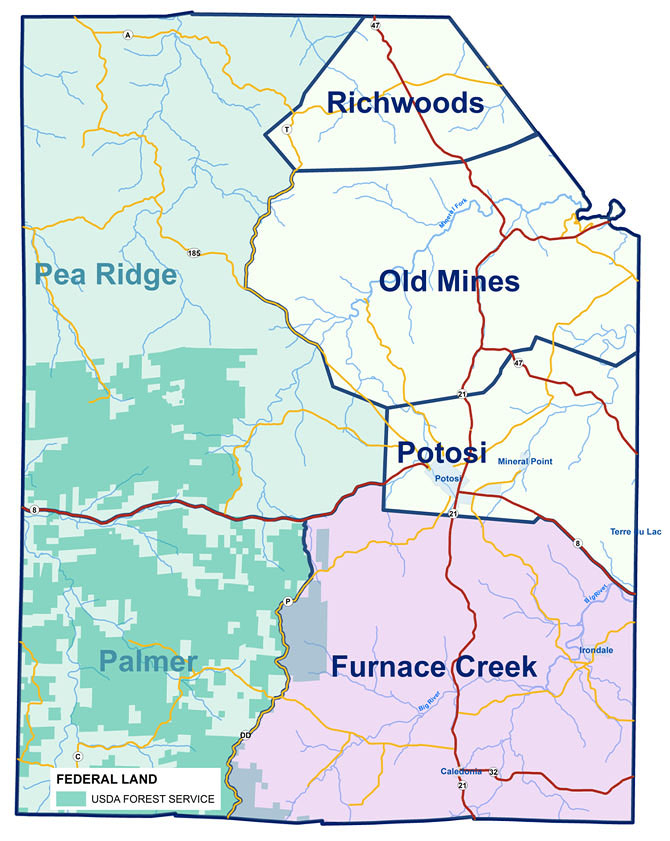Fact Sheet
June 2012
EPA Initiates Remedial Investigation/Feasibility Study, Washington County Lead District - Furnace Creek Superfund Site, Operable Units (OUs) 1 and 2, Washington County, Missouri
INTRODUCTION
On March 10, 2011, the U.S. Environmental Protection Agency (EPA) added the Furnace Creek Site to the National Priorities List (NPL). The NPL is a list of the nation’s hazardous waste sites with the highest priority for cleanup. These sites are eligible for extensive, long-term response action money, as authorized by Congress under the Superfund Program. Furnace Creek is one of six sites located in Washington County (See Figure 1 at bottom). The other sites are being addressed in separate investigations.
In May, EPA Region 7 staff and contractors gathered environmental samples (soil and groundwater) to support the Remedial Investigation/Feasibility Study (RI/FS) at this site.
BACKGROUND
Washington County is part of Missouri’s Old Lead Belt, where mining occurred for several hundred years. Mining activities in Washington County have contributed to elevated levels of lead in soil, groundwater, and surface water in the area. Some county residents have also unknowingly purchased lead-contaminated gravel for use in driveways, parking areas and playgrounds.
Elevated lead levels in the environment can pose a threat to public health, especially for children seven years old and younger, and pregnant women.
PREVIOUS SITE ACTIONS
EPA previously conducted a site inspection and removal action at this site (prior to it qualifying for long-term funding under the NPL). During this effort, EPA collected soil samples from more than 1,500 residential properties and water samples from 1,100 drinking water supply wells within the site boundaries. Reports for these actions can be found at the site repositories (listed below under “ADMINISTRATIVE RECORD”).
Of the 1,500 soil samples taken, 450 had lead levels greater than the health-based standard. These properties were divided into two categories: 1) properties with lead levels greater than 1,200 parts per million (ppm), and 2) properties with lead levels less than 1,200 ppm but greater than 400 ppm. EPA’s initial response at this site focused on cleaning up the properties with the highest levels of lead in them, due to a potentially greater health risk. EPA cleaned up more than 150 properties during this action. The cleanup consisted of excavating and removing contaminated soil and gravel from affected properties and replacing the excavated material with clean fill and hydro-seed.
Of the 1,100 drinking water supply wells tested, six were confirmed to have lead levels in the groundwater that exceeded the Agency’s maximum contaminant level for lead (in water) of 15 micrograms/liter (ug/l). EPA offered and provided an alternate source of drinking water to interested property owners.
REMEDIAL INVESTIGATION (RI)
EPA’s focus for the RI will be on the properties assessed in the previous action that had lead levels between 400 ppm and 1,200 ppm (identified as category no. 2 above). During the RI, EPA will gather samples to determine the nature and extent of contamination at each property; establish cleanup criteria; identify remedial action objectives; and evaluate the technical cost factors that support these objectives. As a part of this process, EPA will conduct a feasibility study. This study will evaluate different alternatives for cleaning up the site and provide recommendations for cleanup costs.
Prior to any site decisions, EPA will present the findings of this process to the community and solicit comments about the next steps toward site cleanup.
During this process, EPA will continue to address newly-identified properties with lead levels greater than 1,200 ppm. EPA will also continue to address contamination in private drinking water supply wells by providing an alternate source of drinking water where lead or cadmium has been identified above health-based levels of concern.
After completion of the RI/FS, EPA will submit a proposed plan to the public for review; present Agency findings in a public forum; and compile comments into a formal EPA document known as a Record of Decision (ROD). The ROD will identify the cleanup objectives that will be used to evaluate how the remaining properties will be addressed.
TECHNICAL ASSISTANCE GRANT
In an effort to help affected communities understand the technical information related to a Superfund site, EPA has established a Technical Assistance Grant Program. The program provides up to $50,000 for a qualified citizens’ group to hire an independent technical advisor. The advisor can assist citizens in their interpretation of technical data, site hazards, and the different scientific technologies used to support site actions.
ADMINISTRATIVE RECORD
During this phase of the Superfund process, EPA will be compiling the site administrative file. The Administrative Record file serves as the official record for the site and contains all site documents. This file is available for review during normal business hours at the following locations:
Washington County Public Library
235 East High Street
Potosi, Missouri 64664
EPA Region 7 Office
Records Center
901 North 5th Street
Kansas City, Kansas 66101
ADDITIONAL INFORMATION
If you have questions about this Fact Sheet or need additional information about the site, please contact:
Debbie Kring
Community Involvement Coordinator
Office of Public Affairs
U.S. EPA Region 7
901 North 5th Street
Kansas City, Kansas 66101
Phone: 913-551-7725
Toll-free: 1-800-223-0425
Email: kring.debbie@epa.gov
Steve Kemp
Remedial Project Manager
Superfund Division
U.S. EPA Region 7
901 North 5th Street
Kansas City, Kansas 66101
Phone: 913-551-7194
Toll-free: 1-800-223-0425
Email: kemp.steve@epa.gov

Figure 1
Furnace Creek and Neighboring Sites
Washington County, Missouri
![[logo] US EPA](../gif/logo_epaseal.gif)